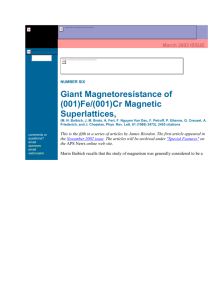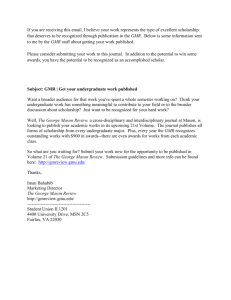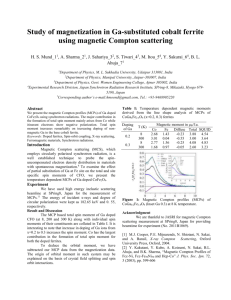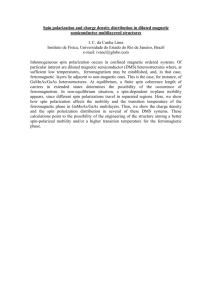presentation source
advertisement
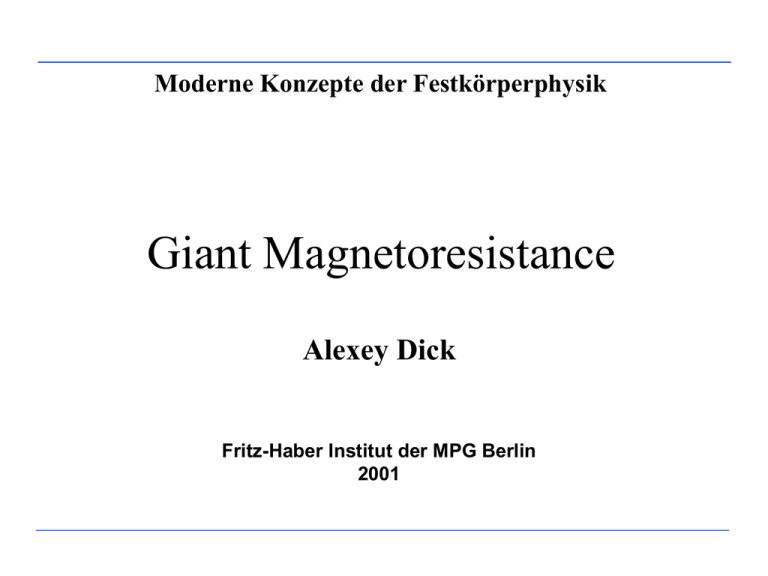
Moderne Konzepte der Festkörperphysik Giant Magnetoresistance Alexey Dick Fritz-Haber Institut der MPG Berlin 2001 Outline Overview of magnetoresistance effects Anisotropic MR Normal MR Mott two current model Interlayer coupling Giant MR (first experiments and qualitative picture) Tunnel MR Colossal MR GMR theory Semiclassical model of conductivity Boltzmann equation Semiclassical Camley-Barnas theory Ab Initio calculations of GMR Applications of GMR Summary Anisotropic MR (1) Magnetoresistance – change in electrical resistance of a material in response to a magnetic field AMR- dependence of the resistivity on the angle Positive MR between the magnetization direction and the current density Spontaneous resistivity anisotropy can be expressed using the resisitivity tensor for monodomain policrystal with magnetization along z axis Negative MR ij EH 0 EH 0 0 0 || Corresponding electric field is Schematic magnetoresistance curves for a ferromagnet E j || j EH j Dependence of the resistivity on the angle between the field and the current is || 2 3 1 || cos 2 3 Magnetic multilayers and giant magnetoresistance : fundamentals and industrial applications, Springer 2000 Magnetische Schichtsysteme in Forshung und Anwendung, Materie und Material, band 2, 1999 Solid State Physics, vol.47, Acad. Press 1994 Anisotropic MR (2) Spontaneous resistivity anisotropy ratio generally defined as SRA SRA || || 3 2 3 Origin – spin-orbit interaction -> coupling adds some orbital contribution to the spin moment, gives rise to a dependence of the electron scattering on the angle between the electron wave vector and the magnetization direction The largest AMR effect at room temperature is found for Ni1-xCox alloys with x close to 0.2, for which SRA ~ 6% For permalloy Ni80Fe20 SRA ~ 4% Effect disappears above Tc Normal MR Lorenz force acting on the charge carriers increase of the resistance in an applied magnetic field All metals have an inherent normal (ordinary) magnetoresistance In ferromagnetic magnetic field is B 0 H a H d M Normal MR obeys the Kohler rule F B 0 0 at B=0; In ferromagnetic materials 0 NMR can be very large when is 0 || or depending on the relative orientation of current and magnetization is very small pure single crystal at low temperature In thin films the concentration of defects is high 0 is high generally NRM is neglected Mott Two-Current Model (1) Sir Neville Mott explained the sudden decrease in resistivity of ferromagnetic metals as they are cooled through the Curie point Model for electrical conductivity in metals conduction current in ferromagnetic metals can be decomposed into two carrier types–current Total conductivity can be expressed as sum of separate contributions from majority and minority electrons Assumptions: spin is preserved spin-flip transitions take place at collisions with magnons, low magnon density at T<Tc, no spin-flip processes occur while scattering on defects conduction is almost by means of s-electrons low effective masses compare to delectrons Schematic band structure for magnetic transition metal At T<Tc scattering is mostly dominated by foreign atoms and defects (I.e. no phonons and magnons scattering) N.H.Mott, Proc. Roy. Soc. A 153, 699 (1936) Mott Two-Current Model (2) The two current model Assume that scattering probabilities can be added ss sd Conductivities satisfy , ns e 2 s , ms* 1 Small portion of foreign atoms -> not only the availability of states is relevant, but the scattering potential of inclusions in host Spin-polarized densities of states for the elemental metals Fe, hcp-Co, Ni and Cu Mott Two-Current Model (3) Scattering potentials are different for majority and minority condiction electrons Schematic representation of the matching of the d bands of the magnetic elements in the middle (b) and elements in columns at the left (a) and right (c) of it in the periodic table d-bands of elements at the left from the host in periodic table resemble the minority d 1 bands, majority – different majorities are scattered more strongly to the right 1 At higher temperatures momentum transfer between two channels are relevant. Electron-magnon scattering increase . Fert derived: 1 1 2 Applies not very high temperatures Interlayer Coupling Cu Layer Thickness (nm) Different types of coupling in a layered magnetic structure The saturation field Hs and as a function of the interlayer thickness x of glass/Fe(6nm)/[Co(1nm)/Cu x A]50 superlattices In 1986 was identified and characterized in Fe/Cr superlattice structures and rare earth yttrium multilayers Transport of spin along the interfaces results in torque acting on the magnetization which is due to the fact that majority and minority electrons have different reflection coefficients at the interfaces. The torque alignes the magnetization according to the associated ratio of reflection coefficients P.Grünberg, R.Schreiber, Y.Pang, M.B.Brodsky and H.Sowers, Phys. Rev.Lett. 57, 2442 (1986) First Evidence of GMR Resistivity versus applied field for Fe/Cr multilayers Relative resistance change as a function of the external magnetic field for Fe/Cr/Fe and 250A thick Fe film Discovered in 1988 in antiferromagnetically coupled magnetic multilayers by Baibich et al and on Fe/Cr superlattices In Fe/Cr multilayers the low field antiparallel configuration was induced by antiferromagnetic coupling between Fe layers across Cr Does not depend on the angle between the current and magnetization spin-orbit coupling and resulting anisotropy play a minor role R R MR=79% at T=4.2K and 20% at room temperature MR AP RP P P AP 1 M.Baibich, J.Brote, A.Fert, F.Nguyen Van Dau, F.Petroff, P.Etienne, G.Greuzet, A.Friederich and J.Chazelas, Phys.Rev.Lett 61, 2472 (1988) Qualitative Picture of GMR Were made with electrical current parallel to the plane of the layers – CIP geometry In CIP geometry GMR arises when layeraveraged electron mean-free path for at least one spin direction is larger than the multilayer period Qualitative expression for MR if the mean free path for both spin directions is much larger than the multilayer period P 1 1 1 AP 4 2 1 MR 4 In magnetic layered structures - dependence of the resistance on the angle between the magnetization directions of successive magnetic layers Phenomenological expression R R 0 RGMR 1 cos 2 Spin-dependent electron scattering for parallel and antiparallel alignment of magnetic films CPP Geometry For CPP the length scale is not determined by the mean free paths of diffusive scattering, but is given by the spin diffusion length sd Average distance between subsequent spin-flip scattering processes. If sd is larger than the multilayer repetition period MR can be analyzed with above simple approach In CPP MR is larger than in CIP Schematic representation of the array of nanowires in an insulating polymer matrix Tunnel MR Obtained in tunnel junctions: two ferromagnetic layers are separated by thin insulating layer (barrier) Approximation: Spin is conserved in the tunneling process Tunnel resistance is different in Parallel and Antiparallel configuration of electrodes RAP RP TMR RP TMR of Co/AL2O3/Permalloy (coersive fields of electrodes are different) Transition metall electrodes TMR 65% at T=4.2K, 40% at room temperature Half-metallic ferromagnets (mixed valence Mn oxides) TMR more 400% at T= 4.2K Colossal MR Found in mixed valence Mn oxides, I.e. La1xSrxMnO3 Conduction is by hopping electrons between Mn3+ and Mn4+ sites, magnetic moments must be parallel ! ferromagnetic state is needed At Tc transition from metal to insulator maximum of resistivity At T>Tc increase of thermally exited carriers decrease fo resistivity Applied magnetic field increase ferromagnetic ordering decrease resistivity Large fields (several Tesla) are needed Top:Magnetization against temperature for La0.75Ca0.25MnO3 for various field values Middle: resisitivity against temperature Bottom: magnetoresistance against temperature Semiclassical Model of Conductivity Electrons are essentially regarded as point like particles (“classical”), but consequences of quantum mechanics are taken into account (“semi”) Having the state of electron defined by n k ,r k and n. In presence of electric and magnetic fields coordinate wave vector and band are changing according to rules: 1 band number is integral of motion -> no interband jumps 2 with a given n 1 n k r vn k k 1 k e E r , t vn k H r , t c Gives rules how in absence of collisions coordinate and wave vector are changing when external electrical and magnetic fields are applied. Gives relation between known band structure and kinetic characteristics Quasi impulse – determined only by externally applied fields, not by periodic lattice field Solid State Physics, N.Ashcroft and N.Mermin Boltzmann Equation How to find distribution function if that for previous infinitely close moment of time is known f (r , k , t ) f (r tv , k F dt , t dt ) f (r , k , t ) f (r tv , k F dt , t dt ) f r , k , t dt t out f r , k , t dt t in Liouville theorem Collisionless movement Some electrons can not reach r , k because of collisions r,k Some electrons reach only because of collisions Leaving only linear dt terms in limit dt0 f f 1 g f v F t r k t coll Drift Collisions If collision term is in relaxation time approximation -> linear differential equation f k t | f (k ) f 0 (k ) | (k ) coll f 0 (k ) - local equilibrium distribution function Steady State Boltzmann Equation f ( k ) f 0 (k ) g ( k ) g (k ) f 0 (k ) 1 f k0 exp Ek EF k BT 1 Assuming no magnetic field , time independent electric field and temperature gradient in steady state f k0 v E g k e E k k k 2e j vk g k V k f k0 2e 2 v v E j V Ek k k k j ˆE 2e 2 E v v ˆ E F k k k V k dS k 2e 2 ˆ vk vk 3 2 vk For metals the changes in distribution function can be restricted to energies close to Fermi surface because for metals dfo/dE is sharply peaked around the Fermi energy Semiclassical Camley-Barnas Theory Hark back to the Fuchs-Sondheimer theory metallic plane-parallel slab is considered as free electron gas with electrons scattering at outer boundaries f ( k ) f 0 (k ) g ( k ) Where f0 is Fermi distribution function g v , r f 0 g v , r v eE v r E 3 m j r e d 3vv g v , r g a z f 0 v , z e Ex vx 1 A exp E v z a z f g v , z e E x v x 0 1 A exp E v z CB model involves spin dependent probability for specular reflection at the outer boundaries. At the interfaces three cases are distinguished: transmission with probability Ti,s Specular reflection with probability Ri,s Diffuse scattering with probability Di,s Probabilities depend on interface I and spin s, T+R+D=1 Systems with different magnetization directions in the different layers are dealt with spin-transmittion coefficients The coefficients A are determined from the boundary conditions for each layer and spin direction. From resulting g function the z-dependent current can be calculated contribution to the conductivity from each spin follows K.Fuchs, Proc.Roy.Soc. 34, 100 (1938) E.H.Sondheimer, Advan.Phys. 1,1 (1952) R.E.Camley and J,Barnas, Phys.Rev.Lett. 63, 664 (1989) Intrinsic GMR (1) ˆ ˆ ˆ - Mott two current model e2 E v v ˆ E F k k k V k Using relaxation time approximation with isotropic relaxation time ratio is determined only by electronic structure GMR Ek EF vk Ek EF vk k 2 i 2 E k AP k EF v AP 2 ki i AP GMR 2 1 k Density of states at the Fermi surface Averaged over Fermi surface N E F v GMR 2 ki N E F v 2 N AP EF vkAP i 2 ki 2 1 GMR is completely determined by the Fermi velocities and Fermi surface as function of the magnetization configuration pure band-structure effect Details of calculation: P. Zahn, I. Mertig, M.Richter and H.Eschrig, Phys. Rev. Lett. 75, 2996 (1995) Intrinsic GMR (2) In Co/Cu multilayered structure in parallel configuration: Differences in potentials are minimal for majority electrons, as Co and Cu d-bands are very similar and there is no large differences in potentials For minority electrons there are potentials steps while transition between Co Cu layers, as dbands are very different On boundary electrons will be scattered Fermi surface for minority carriers is lower lower conductivity conductivity is determined by majority channel of fast electrons In antiparallel configuration both channels are degenerated decrease of mean Fermi speed decrease of conductivity Extrinsic GMR (1) Any defect diffusively scatters Bloch waves additional resistivity of the system Defects: foreign atoms, clusters, boundary roughness etc. Scattering process is described by scattering T-matrix: 1 3 Tkk d r k r V r k r V Microscopic probability of transition is equal according to the Fermi golden rule Pkk 2 2 cN Tkk Ek Ek Proportional to the concentration of scatterers c (deluted case), delta-function – elastic scattering Extrinsic GMR (2) Pkk Pk k Pkk Pk k Pk k In ferromagnetic systems transition matrix contains two spinconserving and two spin-flip terms Spin-flip terms are generally small-> consider only spin-conserving part Electron life-time reverse proportional to the sum over probabilities to scatter in any possible state P 1 k k kk Depends on spin and state. For simplicity take average over states: E E k F k k E k EF k Depending on the potential perturbations and electronic structute life-times are different for different spin directions spin anisotropy Extrinsic GMR (3) P P P P P P AP P GMR is complex effect determined by interplay of intrinsic and extrinsic properties Boltzmann Equation and Scattering (1) Including microscopic probabilities of scattering in Boltzmann equation obtain f k t f 1 f k P f 1 f P k k k k k kk coll k Describes scattering-out from k state Describes scattering-in in k state Principe of microscopic reversibility Quasiclassical equation is Pkk Pkk k k v k Pkk k k Considering both spin-conserving and spin-flip processes get system of intercoupled equations. Dismissing spin-flip obtain two independent systems for majority and minority carriers e2 ˆ V E k EF v k k k P.Zahn, and I.Mertig, Phys. Rev. Lett. 72, 2996 (1995) J.Binder, P.Zahn, and I.Mertig, J. Appl. Phys. 87, 5182 (2000) F.Erler, P.Zahn and I.Mertig, Phys. Rev. B 64, 944081 (2001) Boltzmann Equation and Scattering (2) k k v k Pkk k k Solution of Boltzmann equation Is very hard several approximations are used If one omits scattering-in term in collision term of the equation and take relaxation time constant and spin-independent 2 2e E v v E F k k k V k ˆ This is boundary case of isotropic scattering – all electrons have the same relaxation time Taking spin-dependent isotropic lifetime e2 ˆ V k E RL RL k k k EF k RL The most general case (when scattering-in term is omitted) e2 ˆ V E EF k v v k k k k Relaxation time depends on spin and layer e2 ˆ V E EF v v k k 2 v k v k Applications of GMR Sensors on GMR are very sensitive and can be made very small. For CPP sensors the performance even improved upon miniaturization Use: direct field measurements in disk drives in compute systems, tape heads in consumer products (audio, video), magnetometers, compass systems Position detection permanent magnetization pattern is attached to the object that has to be detected. A sensor detects the change in the field as a result of object displacement sensor field modulation speed, acceleration, force, rotational speed, torque etc. automobiles (e.g. ABS), robotics, assembly lines Comparison of performance of magnetic-field sensors based on GMR and AMR effects Expected turnover for Europe auto sensors, bil.US-$ Spin Valves AF coupling is not a necessary prerequisite for the GMR effect ! AP configuration can be obtained in multilayers in which consecutive layers have different coercitivities Another way Combining hard and soft magnetic layers exchange-biased spin-valve layered structure Schematic cross-section of a “simple” exchange-biased spinvalve layered structure F – magnetically very soft GMR in a Co/Au/Co-layered structure due to different coercitivities Hc of the two Co films Schematic curves of the magnetic moment (a) and resistance (b of a “simple” exchange-biased spinvalve layered structure Only the soft layer is affected by the external magnetic field, magnetization of the pinned layer is fixed relative orientation of the magnetization is changed by external field Read Heads GMR – higher sensitivity and better signal-to-noise ratio Contactless sensors do not exibit mechanical wear Thin film MR heads are produced by photolithographic processing Increase with time of the areal bit density in hard-disk recording, for commercial IBM systems Prototype GMR devices based on exchange-biased spin-valve have been offered by IBM, Hitachi, INESC, Fujitsu Summary Briefly considered different MR effects Anisotropic MR Normal MR Giant MR Tunnel MR Colossal MR Ideas of GMR theory are introduced Semiclassical Camley-Barnas theory Ab Initio calculations of GMR Short notes on GMR applications are done
